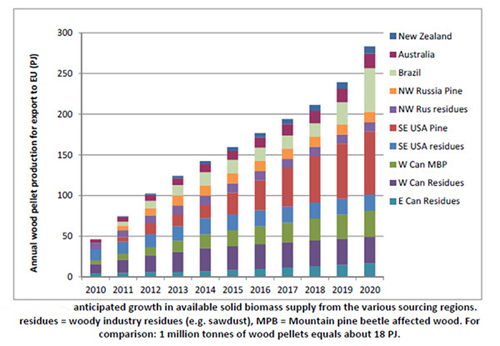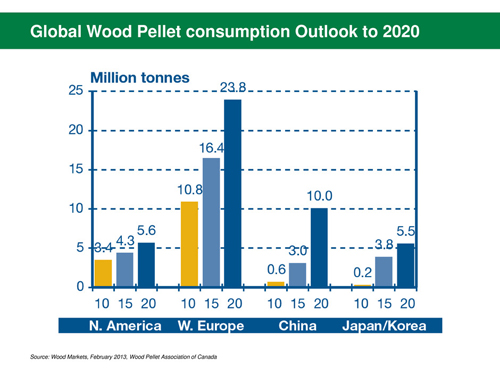Biomass pellet markets around the world
In the past few years, the consumption of biomass pellet fuel has a significant global growth. Since the biomass pellet fuel is considered to be a main fuel in lots of countries, the largest pellet fuel using boom appears in European country, and this boom is closely related to their strong support from their governments and the change of environmental protection goals.
Biomass pellet development all over the world
Production
It has been a continuous growth since the year of 2000 in the market of biomass pellet fuel in Europe. According to the data from EUBCE 2015, in 2000, the world biomass pellet fuel consumption is about 1,700,000 tons which reaches 24,500,000 tons in 2013. 27,000,000 tons in 2014 and 48,000,000 in 2017. Besides, the most noticeable growth is in EU. The current data shows that the production of biomass pellet fuel shares half of the global production, that is to say, in the world's 27,000,000 tons of biomass fuel pellets, 13,500,000 tons is produced in European countries.
The main place of production is in Germany. Germany takes the lead position compared with other European countries such as Sweden, Latvia and Austria. In 2014, their production respectively reached 2,100,000 tons, 1,600,000 tons, 1,300,000 tons and 1,940,000 tons. These four leading biomass pellets producing countries and other European countries contributed to a 45% increase in the pelleting industry by 2010-2017. The fastest growth was between 2013 and 2014, Biomass pellet fuel production has increased 11%.

Consumption
In the growth of biomass pellet fuel consumption, biomass pellet fuel is used for household heating and power generation.UK remains the largest biomass pellet fuel consumption country due to its relative policies which includes government financial subsidy and support to biomass power plant. This is why some coal-fire power plant transformed to biomass pellet power plant. Countries following Britain are Italy, Sweden, Denmark, Germany, Belgium and Netherlands. Biomass pellet fuel in Belgium, Netherlands and the United Kingdom is mostly used for electricity in power stations. In the mean while, biomass pellet fuel used in Italy and Germany is for heating. Governments impose high taxes on natural gas, oil and coal makes biomass pellet fuel become more and more popular in these countries. In general, the EU shares about 80% of global biomass consumption.
The second largest biomass pellet fuel consumption area is North America. It accounts for 11% of global biomass consumption. The United States is the leader of this area. According to the U.S. Department of Agriculture, biomass pellet fuel consumption growth was 14% in 2014, more than double that of the United States five years ago.

Biomass pellet fuel consumption also grows rapidly in Asian countries, with Japan and South Korea being the major buyers of biomass fuel pellets. For example, South Korea consumed only 200,000 tons of biomass pellet fuel in 2012, but increased to 1,900,000 tonnes in 2014. However, the import of biomass pellets fuel dropped significantly in 2015 at a consumption of only 130,000 tons.
The increase demands of biomass pellet fuel stimulated the growth of trade of major exporters of biomass pellet fuel around the world. The United States and Canada are the largest exporters of biomass pellet fuel in the world by far. Data show that the United States exported 2,770,000 metric tons of biomass pellet fuel to the EU in 2013. Exports are reached at 347,000,000 U.S. dollars.USDA (United States Department of Agriculture) also announced that the cost of shipping by 2020 is estimated to be 100,000,000. Followed by Canada is also growing. British Columbia is Canada’s main source of biomass pellet fuel. In 2013, Canada exported more than twice as much as in 2011. In the first half of 2015, this figure was up by 1% from the previous year to about 780,000 tons due to the UK shipments. At the same time, the number of shipments to Italy and Asian countries has been significantly reduced.
In general, the global biomass pellet fuel market has been rapidly growing in the past few years. North America is currently a world leader in the industry. More importantly, it is expected that a new large biomass exporter will emerge soon. The EU is the largest consumer of biomass in the world. It is relevant to its national policies, including subsidies to the particle industry, high taxes on fossil fuels and new climate goals. Pellet exports are also growing due to the growing demand.





Comments